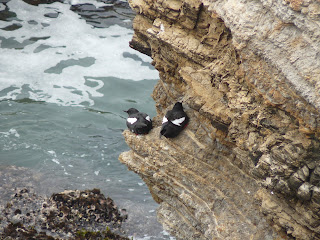Tuesday, June 18, 2019
Nesting Pigeon Guillemot of Montaña de Oro
Pigeon Guillemot (Cepphus Columba) begin appearing along the rocky coast of Montaña de Oro State Park in mid-March. The season of breeding/nesting had begun. The numerous cracks, crevices, and holes in the cliffs and rock formations offer to this plump sea bird, with the startling red legs, a variety of cozy nesting sites. (red arrow points to a possible nest site)
The breeding range for the Guillemot is vast, from the North Pacific waters to Alaska and along the Pacific Coast through California. In winter California Guillemots migrate north to the inland marine waters of Washington.
Pigeon Guillemots belong to the Auk family - related to Murrelet, Auklet, and Puffin.
From my observations at MdO I have come to the conclusion that it takes quite a bit of time for Guillemots to sort out their relationships. Occasionally, I have seen them come ashore where they do bill touching, chasing, and posturing. On one occasion I observed a pair mating. If I had blinked I would have missed it. Much of the mating ritual occurs in the water with much bill touching, and dashing about under the water. Guillemots are quite vocal, their high pitched whistles are prevalent during courtship.
Guillemots are monogamists. Notice how they are in pairs.
Both parents incubate and feed the young. Hatching takes 33 - 38 days. Nestlings are fed small fish and marine invertebrates.
There has been much coming and going into this crevice, noted by the red arrow. The actual nest is difficult to see. I am hopeful there is, or will be, an egg or two to hatch. They are the only Auk that will lay two eggs.
Four to six weeks after hatching young will leave the nest by scrambling and fluttering down to the water. After leaving the nest they are completely independent. This transition between dependence and independence often happens at night. They can dive and swim, but it will take two to three weeks before they are strong enough to fly.
The Pigeon Guillemot scales rock faces and cliffs by flapping its wings combined with the use of sharp claws on its webbed feet.
“Both sexes are alike in appearance, except for the Californian birds - females were found to have larger bills than males.” (a quote from Wikipedia) I have spent quite a bit of time comparing Guillemot bills and see no difference between male and female.
The best place to observe Pigeon Guillemots is on the rocks and cliffs of the small cove below the last overlook on the Bluff Trail. In the many years of observing Guillemots at MdO I have yet to see a juvenile, but remain hopeful of a sighting in the near future.
Subscribe to:
Post Comments (Atom)








No comments:
Post a Comment